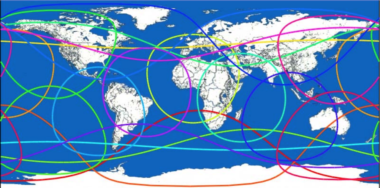MT Laurel, New Jersey — California-based satellite operator Viasat received a green light from the Federal Communications Commission April 23 to provide connectivity service in the U.S. with a medium-Earth-orbit constellation licensed in the Netherlands.
Viasat originally proposed a 24-satellite broadband constellation in 2016, but reduced it to 20 satellites in 2018, saying the lower number would reduce the risk of unwanted signal interference. The satellites would operate at 8,200 kilometers using Ka-band and higher frequency V-band spectrum for uplinks and downlinks.
Viasat is the last of 12 companies to receive a license or market access since the FCC began a processing round in 2016 when a wave of proposals followed OneWeb’s original FCC request. Of the 12, only Boeing’s requests were not approved, since Boeing quietly withdrew its applications for constellations sized at 60 satellites and 2,956 satellites in 2018.
Viasat has focused mainly on building a trio of large geostationary satellites that, with at least 1 terabit of throughput each, stand to be the highest capacity satellites in the world. The first ViaSat-3 satellite is scheduled to launch in 2021.
But Viasat has also shown interest in other orbits, having partnered with SES on medium-Earth-orbit services using the O3b constellation and voicing a willingness to route some internet traffic over other operator’s low-Earth-orbit satellites.

Viasat’s approach of using a Netherlands-licensed constellation could also help the company finance the MEO system. The company used a U.K. business unit to order its ViaSat-2 satellite from Boeing in 2013, enabling the operator to leverage the Export Import Bank of the United States to help finance the program. Most of Viasat’s geostationary satellites in orbit and under construction are licensed in the United Kingdom or Canada.
Viasat’s use of foreign licensing did create one wrinkle in its U.S. MEO application, however. The FCC said it was beyond the agency’s scope to grant market access for intersatellite links Viasat wants to beam traffic between its GEO and MEO satellites, since none of those satellites are licensed in the U.S. and thus can’t be treated as American. The FCC did condition Viasat’s market access on the company avoiding interference to U.S.-licensed GEO satellites that could inadvertently receive its MEO transmissions.
Viasat has not discussed a timeline for building and launching its proposed MEO system, but the FCC’s regulations provide some parameters. Viasat now has six years to build and launch half its MEO satellites, and nine years to deploy the complete constellation in order to retain its full market access rights.
#Space | https://sciencespies.com/space/viasat-gets-fcc-approval-for-meo-constellation/
No comments:
Post a Comment